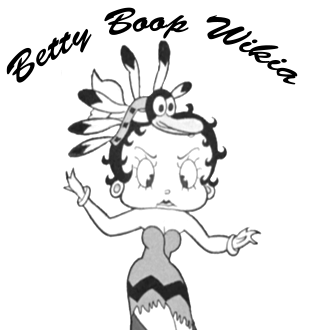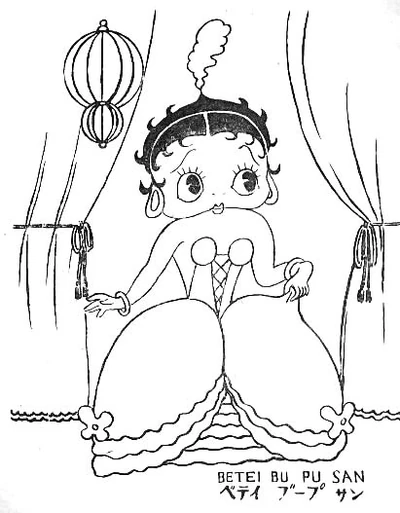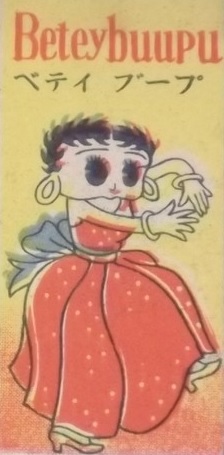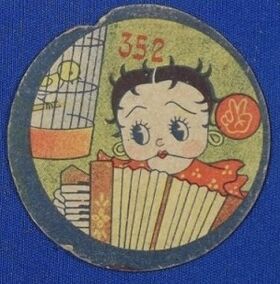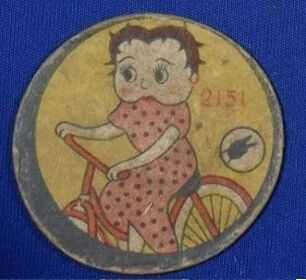Popularity in Japan
| Betty Boop in Japan |
|---|
Popularity in Japan
In Japan, Betty Boop's fame skyrocketed in the 1930s. Paramount distributed Fleischer Studios pictures in Japan and, based on their advertising, also handled Disney films there. Beginning in 1930, Paramount managed American film projects out of its Tokyo headquarters. At that time, the Betty Boop series was marketed by Paramount's Tokyo office. The figure started to appear in Japanese media of the 1930s when she gained popularity.
A Betty Boop cartoon is seen being viewed by a Japanese audience in the movie "Our Neighbor Miss Yae". Osama Tezuka created characters based on the character's big eyes. One such character is Princess Knight, who appears to be sporting Betty Boop's haircut, and seems to somewhat resemble Disney's character Snow White. Later, the development and aesthetics of anime would be influenced by the aesthetics borrowed from American animation.
Tezuka who pioneered manga and anime was inspired by American characters such as Oswald the Lucky Rabbit, Popeye, Olive Oyl, Andy Panda, Scrappy, The Little King, Bugs Bunny, Porky Pig, Mighty Mouse, Mr. Hoppity from Mr. Bug Goes to Town, Tom and Jerry, Felix the Cat, Sylvester the Cat, Chip 'n' Dale, Goofy, Donald Duck and Mickey Mouse. Including Disney classics such as Cinderella, 'The Three Little Pigs and Snow White.[1]
In response to her success in Japan, the Fleischers produced the cartoon "A Language All My Own," in which Betty pilots a jet to Japan, dons a kimono, and performs live in Japanese for an audience. Before the movie was published, animator Myron Waldman requested a few exchange students from Japan to see it in order to ensure that the portrayal was accurate.
The majority of the 1930s original Betty Boop items was produced by little Japanese businesses for the US popular market; however, because copyright and trademark laws were not followed, no records of the illicit merchandise were maintained.
A majority of Japanese people are not aware that Betty Boop was the star of her own cartoon series, the figure is nevertheless immensely famous in Japan. Most Japanese regard her more as a Marilyn Monroe-like idol.
History in Japan
- In some early Japanese artworks, Betty has her original hair color and is a redhead.[2]
- In 1933, Betty and her friends appeared in the 1933 Pre-War manga by Tokio Shunkodo.[3]
- Japanese "Boop-Boop-a-Doop" singer Alice Hamada, known better as Nippon Betty Boop released several Boop-inspired songs in the 1930s, with her most popular being "Tweet Tweet Tweet".
- In 1935 Haruyo Ichikawa recorded the Betty Boop theme song in Japanese.
- In Japan the series first aired on TV in 1959 from May to December.
- The series started airing on Japanese TV in the 1960s. Mariko Mukai dubbed the voice for Betty from the 1960s-1970s.
- In Japan, they consider Betty to be a "sweet American girl" who really knows how to turn heads.
- In 1976 Nintendo released Pretty Puzzle: Betty Boop.
- In 1977 Betty and her brother Bubby Boop became the mascots for Ajinomoto Mayonnaise. During that time the series was airing on TV Tokyo.
- Writer Tsutsui Yasutaka wrote "Betty Boop Den" in 1988, he is said to be a Betty Boop fan and collector.
- In 2002 Betty was licensed for the Sammy Pachinko slot machine titled Betty Boop.
- In 2003 Sammy licensed Betty again for CR Betty Boop, in which featured idol Akina Nakamori as Betty Boop.
- From 2007 to 2009 Betty was featured in several LG phone commercials titled Ladies & Girls and was paired with Yu Aoi.
- In 2013 the character was featured in Line Play, a Japanese social application.
- Betty also appeared as an avatar for Coin Gatcha.
- The character was also portrayed by J-Pop artist Kyary Pamyu Pamyu for a Japanese Coca-Cola Halloween event in 2015.
- Koda Kumi also used Betty Boop as merchandise in 2016 in a collaboration titled Koda Kumi × Betty Boop, for her Best Single Collection.
- In 2020, limited edition merchandise featuring "Betty the Musician" was released.
- CanCam fashion magazine did a Betty Boop (買えるAbemaTV社×Betty Boop™× CanCam it girl) collaboration in 2020.
- Shochiku Co., Ltd., from March 20, 2020 collaborated with Betty Boop for Shochiku Kabuki-ya Honpo.
- Sunshine City Prince Hotel, located in the subculture town of Ikebukuro in Toshima Ward had a limited Betty Boop room in 2022. In addition to the cushions, bed throws, and wall decorations with Betty's illustrations, the guests were dressed in dresses based on the hotel's image color, orange which was drawn especially for this project. A special Betty will welcome you.
- PoneyComb Tokyo collaborated with Betty Boop (BETTY BOOP™×Girls²×パニカムトーキョー) in 2022 for a brand new clothing line.
Gallery
Trivia
- Because of Betty's large eyes, she is very popular in Japan and has been since her debut there in the early 1930s.
- In Japan her name is spelled ベティ・ブープ (Betty Boop), ベティ・ブプさん (Betty Boop San). The most often used honorific, San (さん), is comparable to "Mr." or "Mrs." It is a respectful title. And ベティちゃん (Betty-chan). Chan (ちゃん) expresses charming. Generally speaking, -chan is used for newborns, close friends, little ones, grandparents, and occasionally female teenagers.

